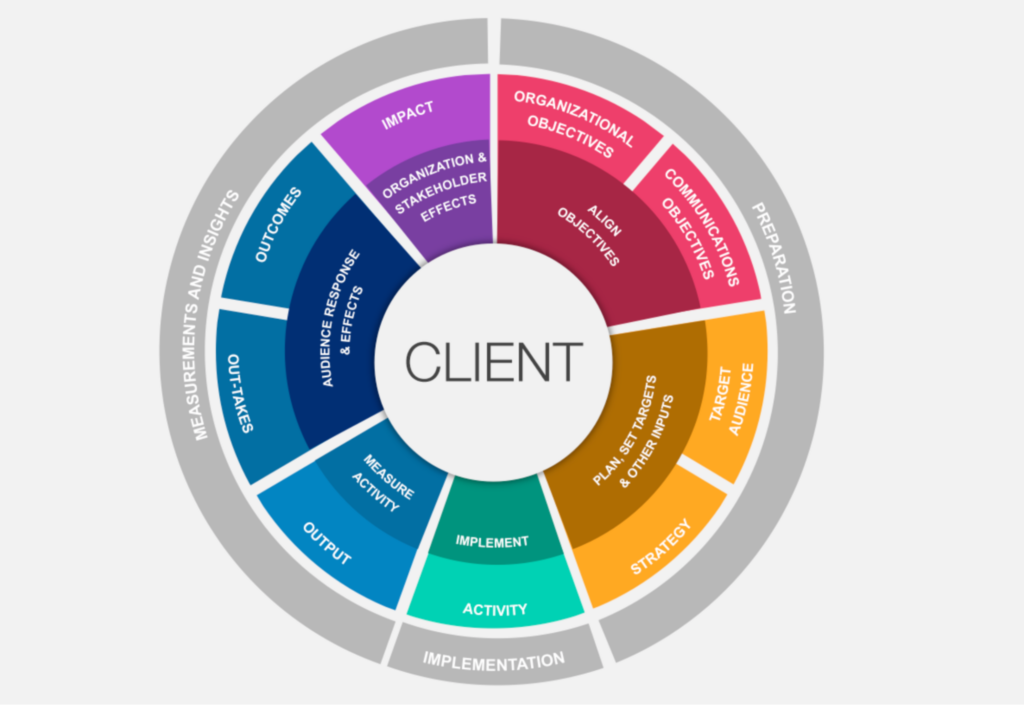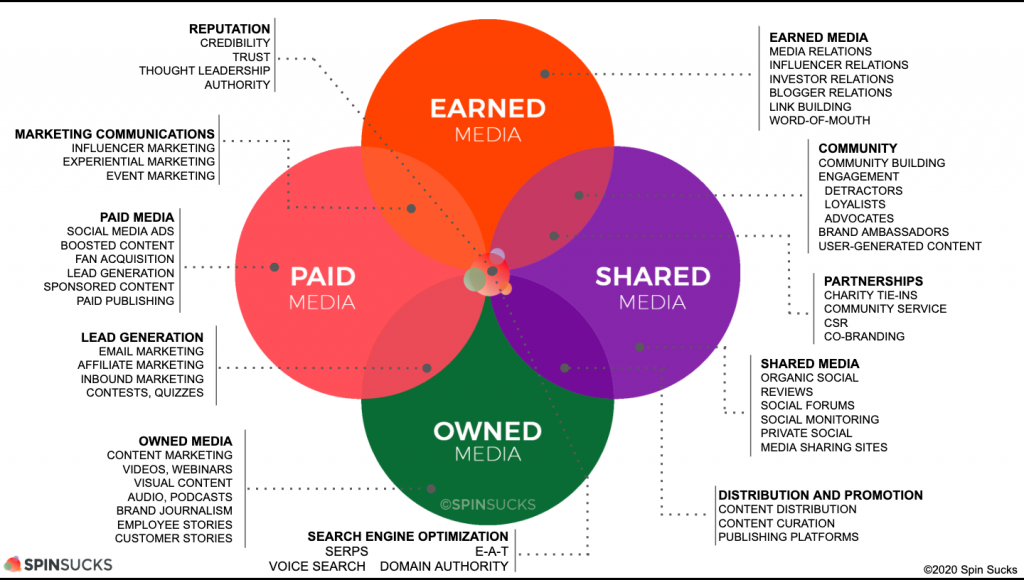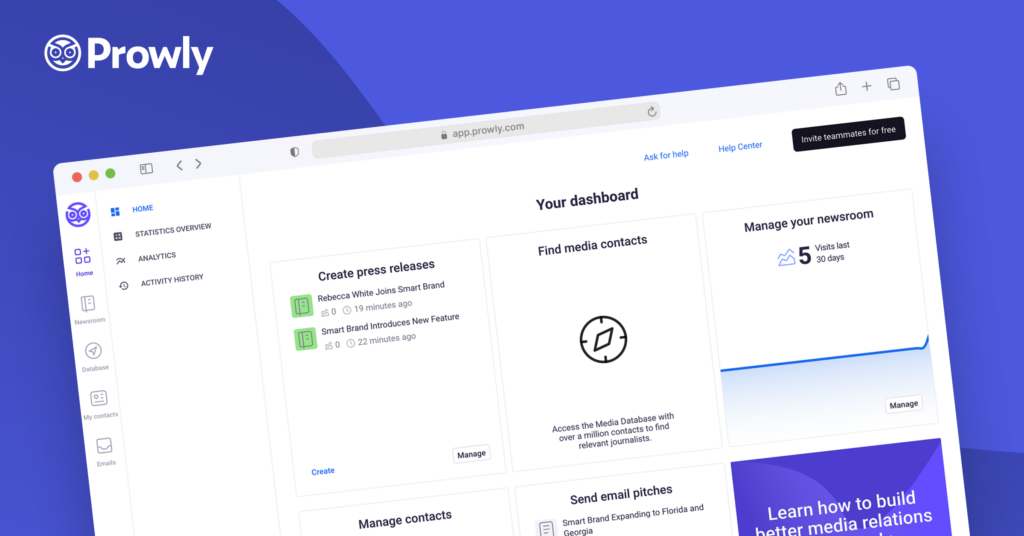Let’s get one thing clear: your brand’s reputation matters.
For better or worse, the public’s perception of you will greatly impact your sales, revenue, and growth.
This is one reason why PR is so vitally important. Without a PR evaluation plan to manage your brand’s image or get the word out about your company story and your products and services, there’s a good chance you’ll be overlooked as your time-crunched prospects go elsewhere.
You know the saying, “failing to plan is planning to fail.” No PR campaign is complete without a plan. In fact, if you don’t launch your PR campaign with clear, measurable goals from the start, you’ll have no real idea of whether it’s working, aside from gut feelings or hunches alone.
It’s worth mentioning that the bigger or wider-reaching your campaign is, the more important measuring its success becomes. When you’re just starting out or investing very little in PR, your evaluation methods don’t need to be as extensive.
Okay, now that we’ve got that out of the way, let’s dive into what PR measurement looks like, the public relations KPIs you’ll want to track, and some tools and tips for getting started.
- What is PR measurement?
- How to measure PR: Evaluation models
- Public relations KPIs for your PR campaigns
- Useful tools to measure PR results
What is PR measurement? Here’s why it matters
PR results have long been difficult to measure. Unlike advertising, PR doesn’t always have a direct correlation to sales. Advertising campaigns usually have clear objectives built into them, complete with analytics you can check to see how it’s going. But of course, many marketing & communications tactics, including PR, don’t include built-in software.
Public relations is about establishing and protecting a brand’s reputation and building relationships with the public. This is entirely different from an ad campaign run on Facebook for a set time with clear parameters.
Still, while PR can be a difficult beast to measure, it’s not impossible. And with clear goal-setting and then monitoring that success, you’ll be able to get the most out of your campaigns. With this approach, you’ll better understand what’s working and what’s not, allowing you to see whether you should continue with the same approach or try something different.
Interested in delving deeper into PR measurement? Catch up on PR Episodes 2024, where industry experts explore effective PR metrics and get practical insights and strategies to enhance your results.
How to measure PR: Evaluation models
PR measurement has always been a hotly debated topic. Once upon a time, AVE (Advertising Value Equivalent) was the only way to measure PR - luckily, it’s no longer the case. The digitization of the industry has provided PR with a whole new array of tools, including qualitative and quantitative monitoring and analytics tools.
If you're interested, we prepared a full guide on "What is Advertising Value Equivalency in PR and AVE's alternatives".
How is the effectiveness of public relations best measured, then?
The Barcelona Principles: PR measurement guidelines
To help standardize PR measurement, a group of PR experts met in 2010 and came up with the Barcelona Principles, a set of guidelines for measuring PR campaigns. These guidelines have become the industry standard for PR measurement today.
To actually follow these guidelines, you might want to use AMEC’s new Integrated Evaluation framework. The framework shows how to ‘operationalize’ the Barcelona Principles and demonstrates how to turn Principles into action and prove the PR value.
Thanks to the interactive element of the integrated evaluation framework, it will guide you through the process from aligning objectives to establishing a PR evaluation plan, setting targets, and then measuring the outputs, outtakes, outcomes, and impact of your work.

PESO PR Evaluation Model
The PESO model officially launched in 2014, when Gini Dietrich’s book Spin Sucks was published. It takes the four media types—paid, earned, shared, and owned—and merges them together:
- Paid media - meaning social media advertising, sponsored content, brand ambassadorship, or influencer marketing. Metrics could include how many people click on your Facebook ad, how many convert to your offer, how many people you have in your contact database, how many are active, and how many respond to your calls-to-action.
- Earned media - also known as publicity or media relations. Metrics might include media, blogger, and influencer scoring, web performance, new audiences, and most certainly the number of people who visit your website after a story runs.
- Shared media - social media, essentially. Think curated content, Facebook Live streams, or Instagram Stories. As Gini Dietrich says, it’s about putting the social back in social media by creating engagement and community. Metric might include social media shares and overall engagement with your social media content.
- Owned media - is what you know as content that lives and breaths on your own website, online newsroom, blog. It is something you own, which allows you to control the messaging and tell the story in a way you want it told. Metrics might include web visitors, time spent on site, or page views.

Now that we have a basis for measuring PR results let’s take a look at some public relations KPIs that you can use to measure the success of your campaigns.
Public relations KPIs for your PR campaigns
Before anything else, it’s crucial to identify your PR goals. You don’t want to waste time or creative energy doing PR campaigns that aren’t measurable or don’t lead you to where you want to be.
Use the SMART method. Make sure your goals are Specific, Measurable, Achievable, Relevant, and Timely. Next, use the customer journey funnel and see which area you want your campaign to focus on. The general stages of the journey that you’ll want to speak to are: awareness, knowledge, interest, preference, and action. Here's how TalkWalker describes them:

Once you’ve set your goals, you’ll have a better idea of what metrics you should measure.
Metrics are industry-specific and vary depending on your campaign and goals.
In our own broad internal assessment in my PR company, we would keep track of hours spent on pitches versus their success in the media. We tracked how much time it took to get a journalist willing to cover our story. This approach helps you to understand how much time you’re investing in each opportunity, giving you an idea of your conversion rates.
We also needed to determine the PR value that each media mention brought to our clients. We started analyzing the traffic that these stories brought to their website, the probable bump we were gaining in SEO, along with general awareness, an idea of how many people would see the article, as well as new customer acquisition.
These metrics are a good place to start, but if you’d like to take things a step farther, you can also consider measuring the following metrics as well:
PR metrics you should be tracking
1. Interactions with your pitch.
Monitoring interactions with your pitch will show you which messages are resonating with journalists. When keeping track of interactions, consider sentiment analysis –the general feeling that your recipients have of your PR outreach. Use any information you gain to refine your pitches over time.
Some important questions to ask include:
- How many people received the email, opened it, forwarded it to colleagues, or clicked on the link?
- How many people replied to ask for more information?
- If the pitch was shared on social media, how many people replied, clicked, retweeted, and shared?
PR tools like Prowly can help you personalize your email pitches, track their effectiveness, and automate follow-ups based on who interacted with your original pitch.
2. Coverage of your outreach.
Once you do get coverage, track all subsequent coverage on social media, online, and in print. It’s a great idea to keep track of the different publications that you’re mentioned in.
Ask yourself:
- How many people are talking about my news?
- Who are the people/publications talking about my startup? How influential are they?
Specific coverage metrics that you can measure include:
Media outreach
This measures the number of pitches and press releases you send out and how well they’re performing. Are they generating the type of coverage you need? Progress in this area can also be measured by how well you build relationships with editors and journalists.
Brand mentions
This refers to the number of times your brand, hashtag, or other related words have been mentioned during the course of your campaign. If your goal is to raise awareness about a brand, this is an important metric to pay attention to. A high volume or spikes in brand mentions mean that people are talking about you or your product.
→ If brand monitoring tools are what you need, don't miss the article "13 Best Brand Monitoring Tools for PR Managers" for a thorough comparison.
Social engagement and reach
If there’s something worse than negative reactions, it’s zero engagement. It simply means that your campaign wasn’t interesting enough to start a conversation. Social media has really changed the way brands communicate with the public, allowing them to have greater reach and easier ways to measure efforts. If you’re on social media or you have your own website, you can measure your engagement rates by examining the number of likes, comments, saves, and shares on your posts. Higher engagement rates will make your posts fare better on algorithms and on search results, boosting your reach.
Event promotion
This is an indicator of how successful a media event is, measured by the number of attendees, its media coverage, and the relationships built with event speakers and attendees.
Earned Media Value
EMV refers to promotion or content that you don’t own and didn’t publish and gained through unpaid marketing or PR efforts. This type of media includes blog features, referrals, reviews, social posts, and influencer marketing.
3. The long-term impact of your coverage.
Interactions and coverage are great for immediate publicity, but it’s also worth measuring the long-term impact of your PR as well. When measuring this, consider how your brand compares to the competition with regards to readership, share of voice, media placement, and sentiment surrounding your coverage. That is, how positive, negative or neutral your coverage is.
Ask yourself:
- How has my social media footprint grown in the past weeks/months/years?
- Have I increased my follower count, interactions, or shares?
- Has my SEO improved? Am I ranking better for certain keywords?
- Is my website seeing increased organic traffic?
- What is the public sentiment surrounding this coverage?
- What’s my share of voice (SOV) like?
SOV is the measure of the market that a brand owns compared to its competitors. It’s a good metric for visibility and gives you an idea of how much dominance you have in an industry.
A brand’s SOV is measured across different channels, from organic traffic, the number of mentions, and social media impressions. A higher share of voice means greater authority and the ability to drive conversations.
4. Email metrics.
Email is a great marketing and PR tool. People who signed up for your email list are already interested in your products or services, so the messaging and approach can be tailor-fit for this targeted audience.
To make sure your PR campaigns are resonating with your target audience, here are some email metrics that you should keep track of:
- Bounces - Undelivered emails
- Growth Rate - The pace at which your email list is growing
- Open rate - The percentage of recipients who open the email pitch out of the recipients who got your message
- Click Rate - The percentage of people who clicked on the link in your email out of the people who received your email pitch
- Conversion Rate - The percentage of people who clicked on a link and completed the desired action
Useful tools to measure PR results
Now that you know how the effectiveness of public relations is best measured, you might want to use a few tools to help you track your PR performance.
Google tools
Take advantage of Google Analytics to study your website traffic and see where you can make changes. Google Alerts is another great tool that you can use. You can set it to alert you when keywords (like your brand) make the news or get mentioned online.
Reporting tools
When it comes to reporting, the International Association for Measurement and Evaluation of Communication (AMEC) has an Integrated Evaluation Framework tool on its site that allows you to create a report of your PR activities and campaign results.
Google Data Studio is another great tool for creating basic reports based on Google Analytics. You can also use PR reporting tools like Prowly, Onclusive, Coverage Book, or Releasd.
Advanced PR monitoring tools
Brand monitoring tools like Mediatoolkit or Brand24 are all good tools for PR professionals and brands alike who would like extensive granular data in one dashboard. These tools provide information on brand mentions, sentiment analysis, and trend insights as well.
Media relations tools
Media relations tools like Prowly make it easier to manage relationships with your media contacts and track your PR performance. More often than not, they offer a media database to find relevant contacts, a PR CRM to stay organized with labels, filtering options, and contact history, as well as email pitch distribution.

PR measurement is not as difficult or time-consuming as it used to be. Access to data, standardized measuring systems, and advanced tools make it easier than ever for us to accurately look at the results of our campaigns and to make changes when necessary.
Whether you decide to go all-in with your monitoring, or just choose one or two different metrics to start with, you’ll be able to benefit when tracking your PR campaigns.
The truth is, no matter what you choose to measure, you can learn something from each and every pitch and media mention. The right metrics combined with a clear goal can show you where you should be spending your time and resources, helping you to create an ongoing and effective PR machine.
About the Author: Renée Warren is an award-winning entrepreneur, inspirational speaker, author, and founder of We Wild Women, a platform that helps entrepreneurs start and scale their own businesses. She's also the host of the celebrated podcast, Into the Wild. Renée firmly believes that the best advice comes from someone who has successfully done it before. Her approach to coaching comes from over 22 years of experience as an entrepreneur and unapologetic risk-taker.

